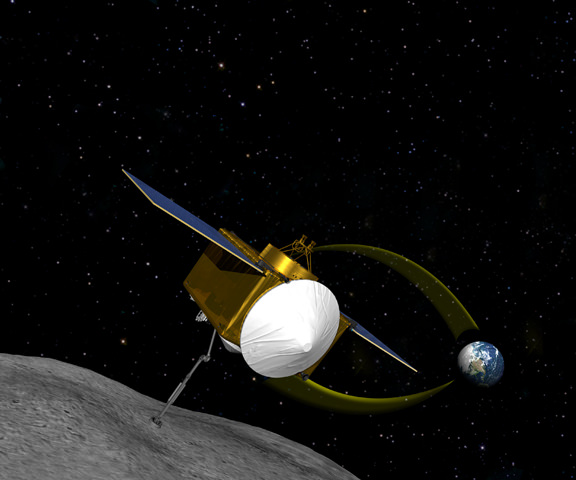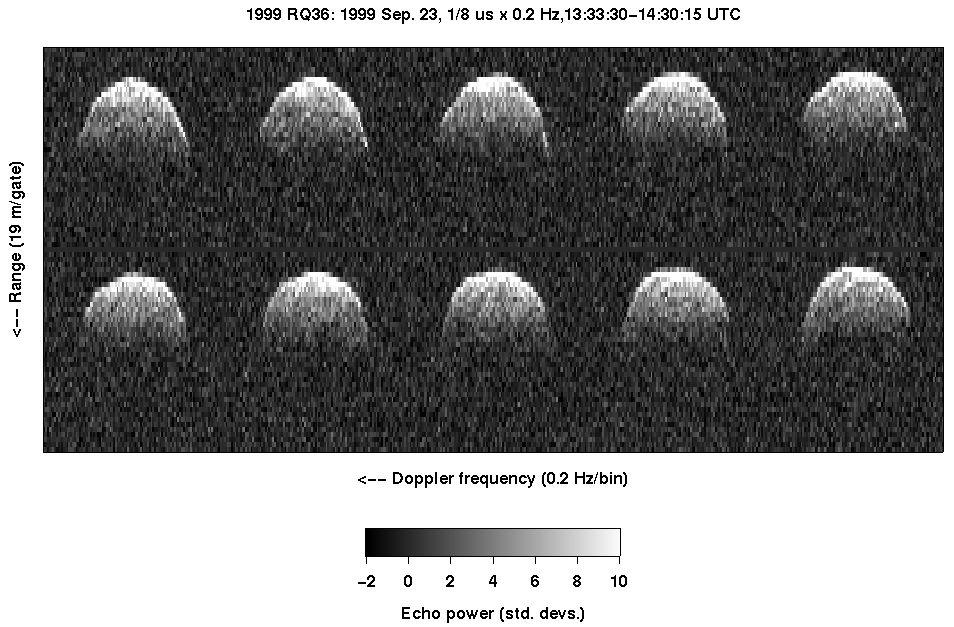[/caption]
Asteroid trackers from Spain have upgraded the chance that asteroid 1999 RQ36 could hit our planet, saying it now has a one-in-a-thousand chance of impacting the Earth in the year 2182. Previous estimates gave a 1 in 1,400 chance that this asteroid could strike Earth sometime between 2169 and 2199. Currently, however, NASA’s Near Earth Object website gives between a 1 in 3,850 and a 1 in 3,570 chance that 1999 RQ35 could potentially impact Earth on Sept. 24, 2182. To make everyone breathe a little easier, that’s a 99.97200000% chance the asteroid will completely miss the Earth.
1999 RQ36 is an asteroid that has been suggested for a robotic sample return mission, to help us learn more about the makeup of NEOs, especially those that have a potential threat to Earth.
The team from Spain, co-led by María Eugenia Sansaturio from Universidad de Valladolid, said knowing this asteroid poses a potential threat in the twenty-second century “may help design in advance mechanisms aimed at deviating the asteroid’s path.”
“The total impact probability of asteroid ‘(101955) 1999 RQ36’ can be estimated in 0.00092 -approximately one-in-a-thousand chance-, but what is most surprising is that over half of this chance (0.00054) corresponds to 2182,” said Sansaturio.
Sansaturio and team have estimated and monitored the potential impacts for this asteroid through 2200. Asteroid 1999 RQ36 was discovered in 1999, but originally was not considered dangerous. In 2009, researches from Italy said their new calculations and observations revealed a chance of impact sometime during a 30 year span in the mid-to late 2100’s. Read that 2009 paper here.
1999 RQ36 is estimated to be about 560 meters wide, more than twice the size of the more well-known asteroid Apophis, which is projected to have a 1 in 250,000 chance of impact in 2036, reduced from the 1 in 45,000 odds calculated earlier. That asteroid is expected to make a record-setting — but harmless — close approach to Earth on Friday, April 13, 2029, when it comes no closer than 18,300 miles above Earth’s surface.

Of course, there is a fair amount of orbital uncertainty, due to the gravitational influences on the asteroid when it passes by the Earth and other objects, plus a minimal amount of influence from the Yarkovsky effect, which is an unbalanced thermal radiation from sunlight hitting one side of the asteroid and not the other that produces a tiny acceleration.
This effect had not been measured for 1999 RQ36 until now. The new research, published in the journal Icarus, predicts what could happen in the upcoming years considering this effect. Up until 2060, the team says the divergence of the impacting orbits is moderate; between 2060 and 2080 it increases 4 orders of magnitude because the asteroid will approach the Earth in those years; then, it increases again on a slight basis until another approach in 2162, it then decreases, and 2182 is the most likely year for the collision.
“The consequence of this complex dynamic is not just the likelihood of a comparatively large impact, but also that a realistic deflection procedure, or path deviation could only be made before the impact in 2080, and more easily, before 2060,” said Sansaturio.
“If this object had been discovered after 2080, the deflection would require a technology that is not currently available,” added Sansaturio. “Therefore, this example suggests that impact monitoring, which up to date does not cover more than 80 or 100 years, may need to encompass more than one century. Thus, the efforts to deviate this type of objects could be conducted with moderate resources, from a technological and financial point of view.”
The research also involved scientists from the University of Pisa (Italy), the Jet Propulsion Laboratory (USA) and INAF-IASF-Rome (Italy).
The proposed robotic mission to this asteroid is called OSIRIS-Rex, the Origins, Spectral Interpretation Resource Identification, and Security, Regolith Explorer, one of three proposals selected by NASA in December 2009 for more study under its New Frontiers program. If chosen the mission would launch in about 2018, and it could provide information about how the solar system was born, and perhaps, shed light on how life began. It also might be one of the first looks at how an asteroid might be deflected. Read more about this proposed mission on the NASA Goddard website.
Sources: Spanish Foundation for Science and Technology via PhysOrg
, NASA’s NEO Program office, New Scientist


Obviously this is no great concern, 2182 is waaay after 2012.
99.972% is already a huge chance that the rock will miss Earth; there’s no need for the useless five “0”s at the end of this percentage figure to emphasize it 🙂
Got hard hat and gold undies? LOL!
Never say never… The recent discovery of a crater in the Northern Sahara desert immediately comes to mind.
http://www.physorg.com/news199331930.html
And the consequences if an object that size hit us are..? I’ve been reading too much mainstream media. When there is no specific concentration on why I should be afraid I feel unwhole. %)
The link to that paper iznogoud; the correct link is here.
Ah, I see now that the link to the paper has been corrected. 🙂
Yes, thanks Ivan!
Weirdly enough, deflecting asteroids is one of the very few things we can do in space and hope to get a return on what we do. We can send probes to the outer planets and that’s really neat. If we could send people to the stars, that would be neater still, but they could not sensibly send back gold, tobacco, potatoes, or slaves. But, deflect an asteroid and save ourselves rebuilding after an impact – that’s a large number divided by large odds, but still (probably) a good return.
We haven’t got the hang of looking at these things. We are still surprised by things we only spotted at the last moment. Spread the 1:1000 odds over the next few hundred years, and factor in several types of objects that are probably out there but we haven’t seen, and the risk adds up. It’s nothing to panic about, but the later we spot them, the harder they are to deflect, so it makes good sense to be prepared. 1999 RQ36 sounds like a good subject to practice our asteroid deflection techniques on before we have to do it for real.
we could have more astronauts throw away cameras and tools. yes! then we will have a debris shield that will save us. it’s all so clear now that littering earth orbit is part of a carefully crafted plan to protect humanity.
Richard Kirk, besides potential good ROI, it is as someone said elsewhere one of the first involuntarily or self-inflicted disasters we will avoid. (We avoided the ozone hole, but not AGW.)
I would say that this study should convince NASA to bump this mission up on their priority list. What better a target for study than something we may have to deflect. If this impacted on land it would wipe out an area the size of a small state like Delaware. 99 percent sounds trivial unless it happens to be headed to your neck of the woods.
Even if it hits Earth, there will be a 75% chance it will hit an ocean anyway.
Plus, by then we will have better weapons after fighting off robots, zombies, aliens, and cybernetic interdimensional demons.
So there.
I say we’ve gained enough from previous so called “poor return” missions to be able to engineer, build, propel, navigate, orbit, land, sample, etc. (with more than one option for each) for a mission to mitigate the possible destruction of Earth.
Imagine how difficult it would be to plan and operate a successful mission without the experiences of previous missions. Meeting up with an object going 35,000 mph, through a hostile environment, millions of miles away isn’t as easy as you may think.
Be careful what you take for granted.
Hmmmm. 2182 eh? Well, by then we will either be living in conditions like the 12th century with just localized village economics and wind /water power, or we will have overcome all of the stupidness we are doing today and have established ourselves as a full, self sustaining Sol based culture.
If the first case is true, then 99.9% of humanity will never know it happend, and if the latter scenario plays out then it will have been just another benign adjustment we made decades earlier.
“Obviously this is no great concern, 2182 is waaay after 2012.”
Fool! Don;t you know that 2182 is 170 years after 2012??? Don’t you realize what this measn??!?!? 170=2*5*17. 2+5+17=24. 24=2*12. 2012! You realize the numerical certainty too late?!?!? We’re doomed!! The Mayans knew this was coming! Do0o0o0o0omed!1!!